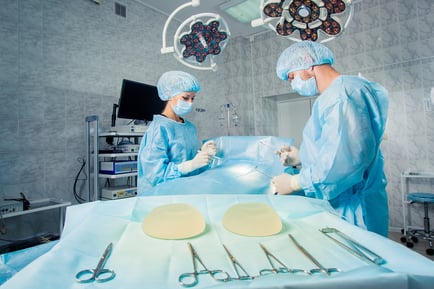The Benefits of a Joint Surgical Approach to Breast Cancer Surgery
6 min read

In many places across the country, including parts of Colorado, a joint approach to breast cancer surgery is either not an option or is extremely complicated to schedule. However, a joint surgical approach, like the one used at Rocky Mountain Breast Specialists (RMBS), ensures patients have an accurate and comprehensive understanding of their surgical options for lumpectomy, mastectomy, and breast reconstruction. Additionally, it eliminates the barriers of excessive wait times and hassle of coordinating separate surgical teams. At RMBS, the multidisciplinary surgical team handles the details, allowing the patient to focus on making the best decisions for their unique treatment and healing journey.
“We’ve developed a very close relationship in regard to patient care,” said Dr. Gerlinde Tynan, FACS, board-certified breast surgeon specializing in surgical disease of the breast, mainly breast cancer, at Rocky Mountain Breast Specialists. “It’s a very streamlined process of getting patients to the operating room with that joint team approach.”
Improved Collaboration and Continuity of Care
By taking a collaborative approach, the RMBS team follows the patient together. This can improve continuity of care, ease of access to care, and ongoing communication throughout treatment and recovery.
“You have the benefit of having your team on the same page from the get-go,” Dr. Tynan said. “Before the patient meets the plastic surgeon, I’ll talk with the plastic surgeon on the phone. I’ll say, ‘Hey, I’m sending someone to see you and here are my thoughts.’ And, of course, our notes go over there. They’ll see the patient, they call me, and then we talk about it. So the process can happen quickly. Usually, it’s within a couple of weeks, where it may take months to get this done elsewhere.”
Increased Treatment Options
 “Working closely with my plastic surgeon is very important because that allows us to offer a wider breadth of options for our patients,” Dr. Tynan said. “Cosmetic options are much more limited when you have breast surgery or mastectomy first and then reconstruction later, than when you can have the two processes combined.”
“Working closely with my plastic surgeon is very important because that allows us to offer a wider breadth of options for our patients,” Dr. Tynan said. “Cosmetic options are much more limited when you have breast surgery or mastectomy first and then reconstruction later, than when you can have the two processes combined.”
Taking a joint surgical approach to treat breast cancer is especially beneficial in the case of a skin-sparing mastectomy or nipple-sparing mastectomy. When oncologic breast surgeons and plastic surgeons work together for these procedures, the patient often has more options for the type of reconstruction she receives, whether it includes breast implants, breast tissue expanders, or tissue flaps.
The joint surgical approach is also useful for breast-conserving surgery. For example, if a woman is receiving a lumpectomy, a partnership can provide the option of a breast reduction. This can create breast symmetry and improve the cosmetic outcome.
Making Good Decisions
Several factors are considered when making decisions about breast cancer surgery and breast reconstruction, including:
- Age of the patient
- Body mass index
- Cancer stage
- Chronic health conditions
- Need for additional treatments
- Patient preferences and priorities
Women considering a prophylactic mastectomy due to an increased risk of breast cancer based on family history or a known BRCA1 or BRCA2 gene mutation may have additional factors or decisions to consider. With a joint approach to breast surgery, women can get their questions answered by a collaborative team. This typically means:
- Improved patient understanding of options
- Increased agreement on appropriate treatment options by providers
- Enhanced communication
- Quicker treatment
Immediate breast reconstructive surgery is often an excellent option for locally advanced or early-stage breast cancer and prophylactic mastectomy. Furthermore, a joint approach to breast cancer surgery may be particularly useful for those needing radiation therapy following a mastectomy. While radiation after breast reconstruction is safe in many cases, it may affect the options available to the patient. In these cases, a joint approach will allow the patient and multidisciplinary team to make more informed decisions about treatment.
While women with inflammatory or advanced breast cancers may not be candidates for immediate reconstruction, the joint approach is still beneficial. It can ensure all options are identified and discussed. This is also true for women who need staged or delayed reconstruction and those who are unsure about reconstructive surgery.
Responding to the Unexpected
 The unexpected can always happen, no matter how well-planned a surgery is. A collaborative oncologic and plastic surgery team may be better able to adjust to last-minute changes. For example, if during a sentinel lymph node biopsy, it’s found that an unplanned axillary lymph node dissection is necessary, an oncologic breast surgeon may make a decision that works well for breast cancer treatment but does not consider plastic surgery needs. By working together during a conservative breast surgery or mastectomy, a multidisciplinary surgical team may be able to make choices that lead to more satisfactory cosmetic outcomes in addition to an improved clinical outcome.
The unexpected can always happen, no matter how well-planned a surgery is. A collaborative oncologic and plastic surgery team may be better able to adjust to last-minute changes. For example, if during a sentinel lymph node biopsy, it’s found that an unplanned axillary lymph node dissection is necessary, an oncologic breast surgeon may make a decision that works well for breast cancer treatment but does not consider plastic surgery needs. By working together during a conservative breast surgery or mastectomy, a multidisciplinary surgical team may be able to make choices that lead to more satisfactory cosmetic outcomes in addition to an improved clinical outcome.
A joint approach to breast cancer surgery can aid in developing a comprehensive follow-up plan. That includes creating a strategy for pain management to maximize patient comfort while minimizing the use of controlled pain medications.
“Any time you have good communication between providers rather than, ‘I'm done with my part, here's a handoff,’ you have a better overall outcome,” Dr. Tynan said. “They know exactly what I did. I know exactly what they did because we’re in the operating room together. So, let’s say, if one side was a little difficult or I’m a little worried about something, they know that and vice versa. Or they know that I had to remove a lot of lymph nodes and so they’re going to be extra careful in this area. I think that communication leads to better outcomes overall.”
Reducing Costs and Time for Facilities and Patients
A 2022 article published in the Annals of Surgical Oncology found that the cost of care of mastectomy with immediate breast reconstruction after mastectomy was significantly lower than that of delayed or staged reconstruction. The mean cost of an immediate reconstructive surgery was about a quarter less than staged reconstruction, the highest cost option.
Further, the study found that health care resource utilization related to hospital readmission, reoperations, and all related post-surgical emergency room visits, was lowest for patients with immediate breast reconstruction. Health care resource utilization was approximately 23% higher for staged reconstruction and 13% higher for delayed reconstructive surgery.
Depending on insurance coverage, the out-of-pocket medical costs for patients may not be significantly different between immediate, delayed, or staged reconstruction. However, additional costs related to time off work, childcare, or eldercare can be reduced by performing mastectomy or lumpectomy with immediate reconstruction through a joint surgical approach. Needing to take additional time off of work or having the burden of cost for added childcare or eldercare may also increase a patient’s stress level or extend the overall recovery period.
Psychosocial Benefits
“Not only is it just one surgery, but we know that there is an overall psychological benefit to waking up after surgery with breasts,” Dr. Tynan said. “For many women, the data has shown that it is overall beneficial.”
Breast reconstruction has been linked to decreased anxiety, increased health-related quality of life, and improved overall psychosocial health for women who have had a mastectomy. Women who have received mastectomies with immediate breast reconstruction tend to report increased breast satisfaction. Additionally, immediate breast reconstructive surgery has been associated with increased sexual well-being.
For patients, taking a joint approach to breast cancer surgery not only addresses needed breast cancer treatment or prevention but can help set them up for success financially and psychologically. It also reduces time spent waiting for or recovering from surgery. The oncology team benefits are also significant, with increased collaboration, decreased opportunities for miscommunication, and lower cost of care.
Learn more about the benefits of Rocky Mountain Breast Specialists’ multidisciplinary approach to breast cancer surgery. Refer a patient today.